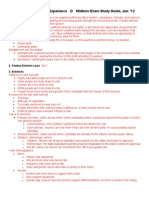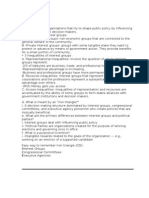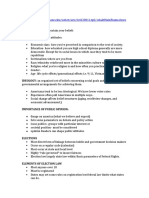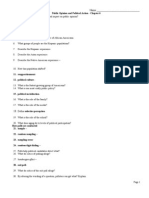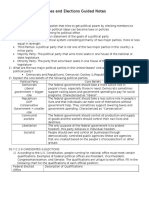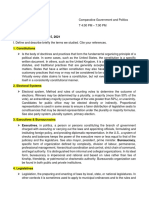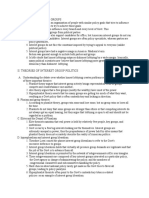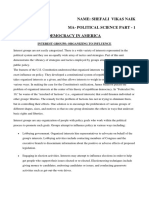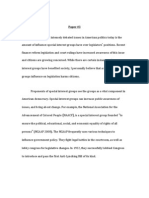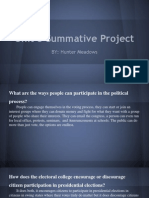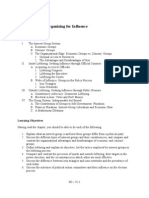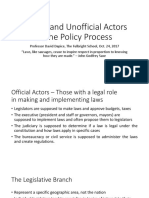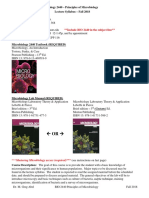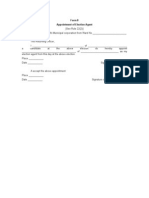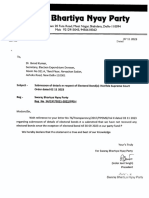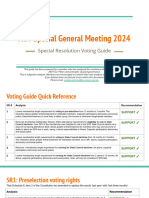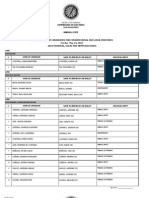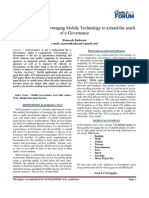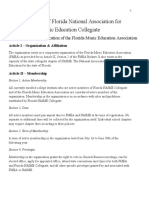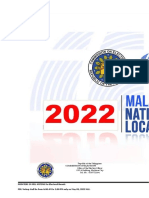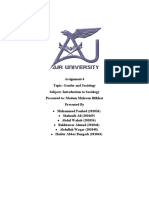Chapter 7 Study GuideInterest Groups
1. Define interest groups and describe their functions.
Interest groups are organized groups of individuals sharing common objectives who actively attempt to
influence policymakers by sending lobbyists and participating in other lobbying campaigns.
2. Give three reasons why people participate in interest groups.
a. Solidary incentivescompanionship, a sense of belonging, and the pleasure of
associating with others
b. Material incentivesprotection from legislation that would negatively impact members
business, other economic opportunities or freebies
c. Purposive incentivesthe satisfaction of taking action for ones beliefs and principles,
strong agreement with the groups values and goals
3. Identify the major categories of interest groups and name some representatives in the business,
agricultural, and labour sectors.
a. Economic: Designed to promote the interests of specific businesses (business: US
Chamber of Commerce; agricultural: American Farm Bureau Federation; labour:
American Federation of Labour)
b. Environmental: Focus on protecting the environment in general or unique ecological
niches (National Audubon Society, National Wildlife Federation, Greenpeace Society)
c. Public Interest: Goals are to advance the best interests of the overall community
(Common Cause, League of Women Voters, American Civil Liberties Union)
d. Single-Issue: Focus on just one issue, representing one viewpoint (AARP, National Rifle
Association, American Israel Public Affairs Committee)
e. Foreign Governments: Lobby whenever vital legislation affecting their trade interests is
considered (Japan, South Korea, EU nations)
4. What are some of the factors that make an interest group powerful?
Size, resources, leadership, cohesiveness.
5. Identify the direct tactics used by interest groups.
a. Lobbyingengaging in private meetings with public officials, testify before
congressional committees, testifying before executive rulemaking agencies such as the
Federal Trade Commission or the Consumer Product Safety Commission, assisting
legislators or bureaucrats in drafting legislation, inviting legislators to social occasions,
providing political information to legislators and other government officials, and
supplying nominations for federal appointments
b. Rating Systemsdescribe legislators voting records in relation to how often their
principles agreed with those of the interest group
c. Building Alliancesgroups combine efforts and expenses in order to reach a wider
audience and multiply their influence
d. Campaign Assistancegroups endorse a candidate and contribute election funds
6. Identify the indirect tactics used by interest groups.
a. Public Pressure advertising outreach, polls to back up claims that groups opinion
aligns with public opinion, use public relations to create favourable opinion toward an
interest group or other corporation
b. Using Constituents as Lobbyistsinterest group tries to mobilize large numbers of
constituents to write, phone, or send e-mails to legislators.
7. What are some benefits and drawbacks of tactics such as demonstrations and boycotts?
They tend to get good press coverage, but demonstrations can turn violent, turning suspicion or fear
toward the cause being demonstrated for, and boycotts need widespread support to have any amount
of effectiveness.
8. What types of regulations on lobbyists are in place today?
Lobbyists must register, disclose the general nature of their lobbying effort in a semiannual report which
must also include the specific issues and bill numbers, the estimated cost of the campaign, and a list of
the branches of government contacted (though named of individuals contacted need not be reported).
Chapter 8 Study GuidePolitical Parties
1. Distinguish between a political party, an interest group, and a faction.
a. Political PartyA group of political activists who organize to win elections, operate the
government, and determine public policy
b. Interest Group Organized groups of individuals sharing common objectives who
actively attempt to influence policymakers
c. FactionA group or bloc in a legislature or political party acting in pursuit of some
special interest or position
2. What are the functions of a political party?
a. Recruiting candidates for public office
b. Organising and running elections
c. Presenting alternative policies to the electorate
d. Accepting responsibility for operating the government
e. Acting as the organized opposition to the party in power
3. What led to the creation of our first two political parties?
Arguments over whether or not the Constitution should be adopted or ratified.
4. What was the focus during the era of personal politics?
Political competition took place among individual Republican aspirants rather than as debate between
two parties.
5. When did our current 2 party system occur in history?
In the 1790s, based on the differing views on central government held by Jefferson and Hamilton.
6. Describe some of the core constituents and economic beliefs of the Republican and Democratic
Parties.
Republicans: Upper-income, businesspeople, white evangelical Christians, men, rural people, people
living in the South/the Rocky Mountain states/the Great Plains. Republicans are more supportive of the
private marketplace and believe more strongly in an ethic of self-reliance and limited government.
Democrats: Lower-income, labour union members, Jewish, Hispanic, African-American, women, city
dwellers, people living on the West Coast/in the Northeast. Democrats are more likely to approve of
social welfare spending, support government regulation of business, endorse measures to improve the
situation of minorities, and to support assisting the elderly with their medical expenses.
7. Describe the three faces of a political party:
a. Party OrganisationThe formal structure and leadership of a political party, including
election committees; local, state, and national executives; and paid professional staff.
b. Party in ElectorateThose members of the general public who identify with a political
party or who express a preference for one party over another.
c. Party-in-GovernmentAll of the elected and appointed officials who identify with a
political party.
8. How does the winner-take all election system work against third parties?
Established major parties need fewer signatures to place their candidates on the ballot than minor
parties (due to the fact that how many signatures required is often based on the total party vote in the
last general election). Third party office holders must be counted with one of the major parties to obtain
a committee assignment. They face restrictions on campaign financing and federal matching.
9. Whats the difference between ideological third parties and splinter parties?
Ideological third parties view themselves as political outsiders and do not think in terms of immediate
electoral success. Splinter parties view themselves as being in the right and split the vote of the party
they splinter from.
10. What is realignment?
A process in which a substantial group of voters switches party allegiance, producing a long-term change
in the political landscape.
11. Whats the relationship between the rise of independent voters and split ticket voting?
As the number of voters who call themselves independents increases, so does the frequency of split-
ticket voting.
12. Define the concept of demographically based political tipping.
Tipping in a phenomenon that occurs when a group that is becoming more numerous over time grows
large enough to change the political balance in a district, state, or country.
13. What makes the author think the public prefers divided government?
The population identifying with any one party will maintain relatively stable, swinging upwards and
downwards in number.

